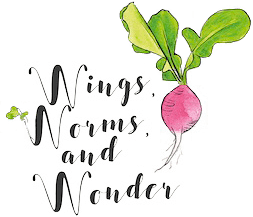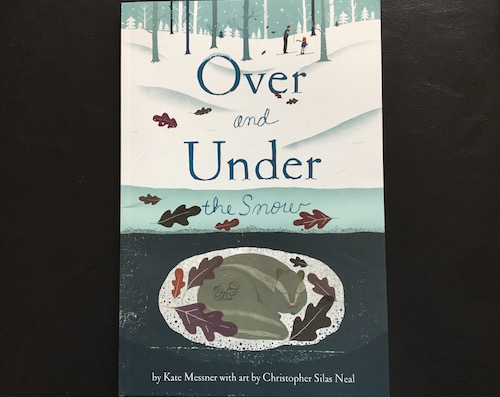Category: Nature Art, Nature Journaling, Wonder Wednesday
Sometimes, when we are in the thick of winter, it can be tricky to come up with ideas for what to paint in the nature journal. How many times can you paint evergreens, bare trees, and snow right?
And speaking of snow and whites, why is using white so elusive in watercolor painting?

Check out that subtle warm sunset fade in behind the blue snow shadows! Gorgeous!
Well, we are getting to the bottom of winter inspiration and the watercolor white mystery today! To solve these conundrums, I’ve got some inspiration for you and a project!
The Inspiration
I recently bought 3 children’s books on winter to use in my workshops that I am absolutely loving. Not only because of the stories and info within, but primarily because of the illustrations!
Let’s check em out:
Over and Under the Snow
by Kate Messner, illustrations by Christopher Silas Neal
This is the only non-fiction book of the 3. It tells a story about the world of the subnivean zone – the layer of tunnels and air pockets between the earth and the top of the snow layer.

The story is framed by a child cross country skiing over the top of the snow and discovering signs of the active world below inside the snow.
The whimsically realistic illustrations show us the animal happenings busy, sleepy, and mysterious white winter world beneath our feet!
Here Comes Jack Frost
by Kazuno Kohara
This is a fun little story about a child, bored with being inside because all his animal friends are hibernating for winter, who gets a visit from Jack Frost.
It’s not a holiday story in any way – just a snowy winter story. Jack Frost tries to elude the boy, but he is too clever and they end up being winter play mates.
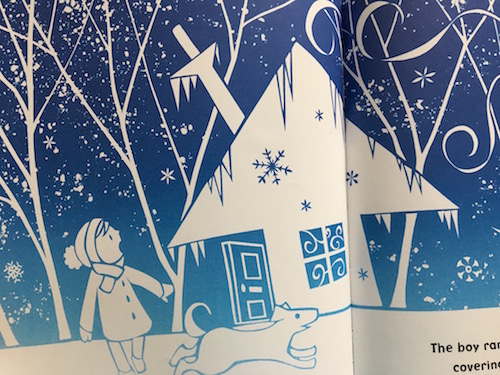
The kicker of this story is the stellar wood cut illustrations. They are gorgeous, whimsical, and I think will inspire the imagination while you are inside and out!
The Snowy Day
by Ezra Jack Keats
This is the classic snowy tale, and rightfully so. I just love it for so many reasons and am so happy to finally own a copy. The illustrations are painted collage and story is innately sweet.
The child, Peter, goes out into the city to play in the snow independently, peacefully, and quietly, and discovers many wintery nature whispers along the way.

The illustrations in this book are spectacular for learning new ways to think about portraying white in paintings. I especially love how Keats uses pink in the snow. It give the images a cozy and wonder filled feel. It’s easy to depend on blues when painting whites and snow, but Keats is a master of bringing warmth to the winter whites.
The Project
& White in Watercolor
First, whether you have children or not, do check out these books from your library and use them as inspiration! I use children’s books all the time as references! They are the best!

Such a dreamy background scape!!!
For each book: Choose 3 illustrations from the book that you love as references – in entirety or elements of, so 9 inspiration pages total.
Then, create nature journal pages inspired by the images you chose from each book, so 3 journal pages in all. You don’t have to do this all in one day of course!
But what about the white? How do we paint snow?
There are a few routes you can take when working with whites. All good, all fun, and all serve a different purpose to make white in watercolor less mysterious!
First, the traditional
In formal watercolor, the white is the white of the paper, left unpainted. So for your image inspired by Here Comes Jack Frost, you will just leave areas untouched by paint – getting a very graphic look.
This can be achieved by not painting areas, that’s what I’m doing here, or you can mask off areas using tape or a frisket masking medium. But we’re keeping it simple here and masking medium is a whole other can of worms, so if you’re interested, check the link in Seeds to Sprout for my free class. I teach the basics of masking there.)
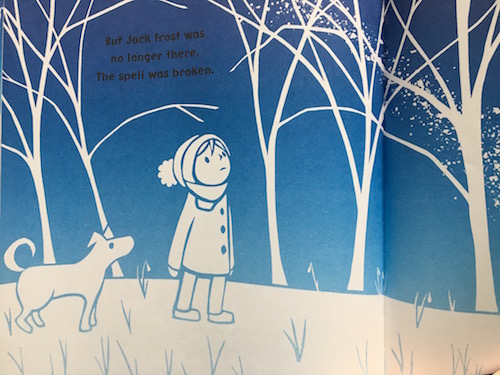
Second, shadows
Snowy winter shadows are generally shades of blue and gray, like illustrated in Over and under the Snow. Try leaving the whites page white and then delineating shapes and images with their shadows in tints and shades of blues. Like in the snow mounds here.

Third, reflected light
One of the things that makes The Snowy Day so amazing is how Keats adds depth with warm background colors reflected into the snowscapes. From the pinks and yellows of the buildings in the background to the green shadows in the snow angels. (I know green isn’t a warm color technically, but it has yellow in it so in a snow scene I’m counting it as warmer.)
He is also so gloriously loose in his style. Try getting loose with the realistic interpretations by adding in warm reflected colors from the sun or other imagery like cardinals in your image.

Fourth, gouache, acrylic, & iridescent paints
Once you have your images nearly complete, you may want to go in and add some pops of bright white in the Snowy Day inspired image, tighten up some edges in the Here Comes Jack Frost image, or add snow onto an object in the Over and Under the Snow inspired image.
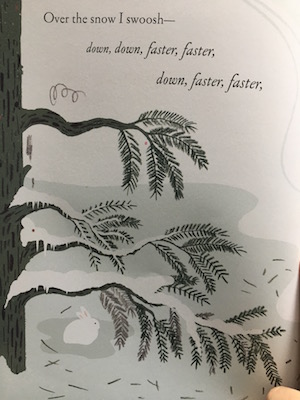
To do this, use opaque white paint such as gouache or acrylic white paint. Make sure your watercolor is completely dry or else the pigment could blend into your white – which may look awesome, so maybe try that too, but not where you want bright white pops.
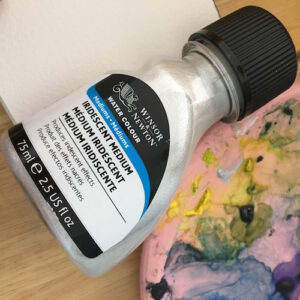
If you want to get fancy and add a little whimsy, try playing around with iridescent medium added to your whites (or shadow colors) to make them sparkle! I love pops of a little sparkle and sheen here and there, especially in the white highlights!

Notice how the outlines seamlessly change from blue to white as the image moves from snow to sky being in the background. So nice and so subtle!
Okay! So have fun with this project! I know a some of you have mentioned needing a little winter nature journal inspiration, so I hope this helps! Enjoy and I can’t wait to see what you make!
Here’s what I came up with:
